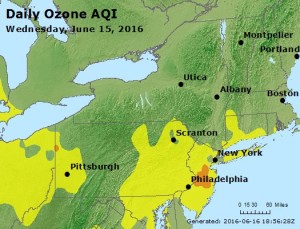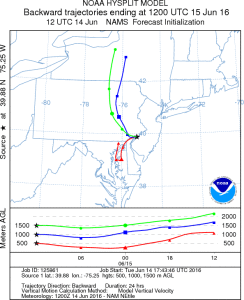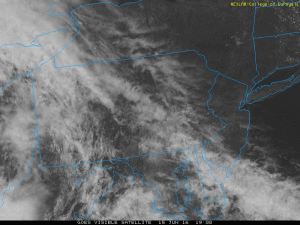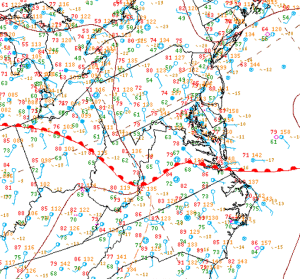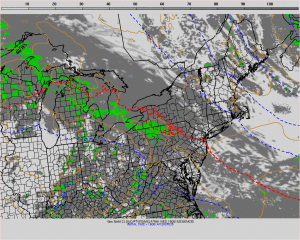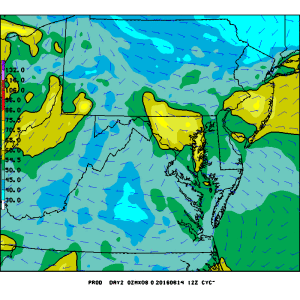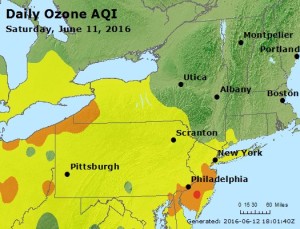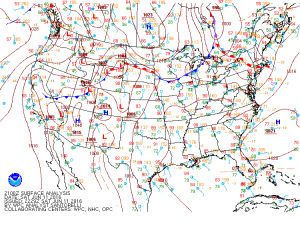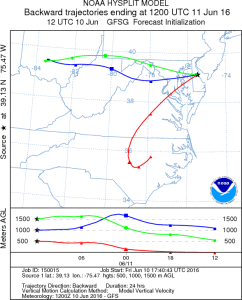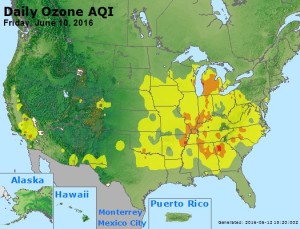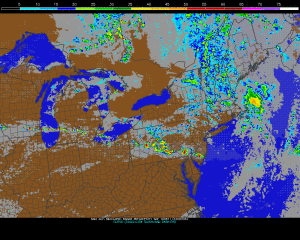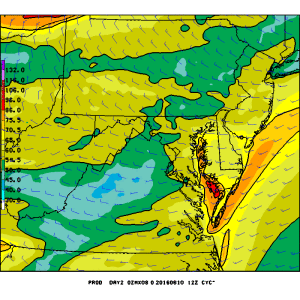Medium Range Air Quality Outlook
Mid-Atlantic Region
Issued: Wednesday, June 22, 2016
Valid: June 23-27, 2016 (Thursday-Monday)
Summary:
Synoptic conditions are still conducive for a possible ozone event this weekend into Monday, but the setup is not as optimal today, making widespread ozone exceedances less likely, but chances still remain for isolated USG ozone along the I-95 Corridor. On Thursday, the majority of the Mid-Atlantic will experience widespread clouds and precipitation as a wave of low pressure moves through from west to east, making the chance for an ozone exceedance Slight.
High pressure will build back into the region from the north on Friday, allowing skies to clear and surface winds to subside. Northwesterly back trajectories and temperatures only reaching the low 80s °F should be sufficient to limit ozone production, with the chances for an exceedance only rising to Marginal. An upper level ridge will build eastward over the region Saturday and Sunday, but its advancement will be impeded by the remnants of Thursday’s wave’s vorticity, which will spin offshore as a weakly organized circulation. There is a trend today toward keeping this feature offshore through the weekend and moving it back toward the coast on Monday. This, along with the position of the surface high during the weekend, is shifting back trajectories more strongly onshore through the end of the period. As a result, classic conditions for a high ozone event will not be in place, but isolated exceedances along I-95 in particular are still likely, especially on Sunday and Monday. The main question for Monday focuses on organized precipitation forming ahead of the next cold front, which the forecast models show extending across the entire Mid-Atlantic from west to east, reaching I-95 by 00Z. At this point, locations along and east of I-95 may see enough sun for an additional day of isolated USG ozone. Therefore, the chances for an ozone exceedance are Appreciable on Saturday-Monday.
Discussion:
The weather forecast models are in close agreement regarding the synoptic pattern through the medium range, with only slight differences at the end of the medium range, except for the NAM, which is an outlier for the entire period. The models consulted for this analysis were the 06Z NAM and GFS and 00Z ECMWF. A wave of low pressure initiated aloft today will ride the front currently draped across the central Mid-Atlantic near the Mason-Dixon Line, reaching western PA/WV by early Thursday morning. The wave will pull the stationary front slightly northward as a warm front, to the vicinity of central PA/NJ. The GFS and EC are in consensus today with the placement of this front and its associated precipitation, showing the heaviest precipitation falling across the northern and central Mid-Atlantic through 12Z. By the afternoon, the heaviest precipitation will push southward across the central Mid-Atlantic. High pressure building across the northern Plains and southern ON on Thursday ahead of an amplifying upper level ridge centered over the Plains will shift southeastward towards the northern Mid-Atlantic on Friday, forcing the front and its surface low southward into NC. This ridge is tracking slightly slower in today’s guidance, with its eastern edge reaching the western Mid-Atlantic by 12Z Saturday and remaining in place until Saturday afternoon, when it finally shifts further eastward and covers the entire Mid-Atlantic through the weekend. It appears the main reason the upper level ridge is slower to build over the Mid-Atlantic is because the EC, and GFS to a lesser extent, holds onto Thursday’s wave’s shortwave energy and keeps it organized offshore, over the Atlantic before bringing it back along the coast on Monday. The main impact of this feature may be to promote onshore flow for Sunday and Monday. A mid-level ridge will hook up with the Bermuda High on Saturday, and remain in place through early Monday. A potent upper shortwave passing to the north of the Great Lakes on Monday will dig out a weak trough that will pull a cold front to the eastern Ohio River Valley, but the GFS and EC diverge slightly in the strength of the trough and its associated front. The GFS has a more compact upper level trough while the EC’s trough is more spread out and diffuse with the associated vorticity. This results in a faster progression of the cold front for the GFS, but the differences are relatively minor and expected with a feature that is 5 days away. Despite the timing differences, both the GFS and EC develop a strong line of precipitation ahead of the front that moves into the Mid-Atlantic on Monday from west to east, reaching just west of the I-95 Corridor by 00Z.
Rain will arrive in the western Mid-Atlantic overnight tonight and work its way eastward across the northern and central Mid-Atlantic through Thursday morning. In the afternoon, the heaviest precipitation will shift southward, as diurnal heating and outflow from the morning’s precipitation fire up thunderstorms across the central Mid-Atlantic. It still appears that NC will be spared of the clouds and precipitation associated with this system through Thursday, with intense afternoon sunshine and temperatures into the 90S °F. The 06Z air quality models, however, only show Moderate ozone levels across NC, with the rest of the Mid-Atlantic well into the Good range due to persistent cloud cover and precipitation. Therefore, the chance of an ozone exceedance will remain Slight for Thursday.
The northern Mid-Atlantic will clear on Friday as surface high pressure builds southeastward from southern ON, pushing the cold front southward into NC by 12Z Friday. Lingering instability showers are possible across the central Mid-Atlantic during the morning, with heavier rain and thunderstorms developing throughout the southern Mid-Atlantic along and ahead of the front. The mid-levels will cool slightly across the northern Mid-Atlantic in response to the frontal passage, moderating temperatures slightly, but we have seen recently that temperatures in the low 80s °F have been more than sufficient for ozone levels to rise along the I-95 Corridor, assuming sufficient stagnation. 06Z GFS back trajectories for the I-95 Corridor now show substantial northwesterly flow from the Great Lakes region, which should be relatively clean. Nevertheless, full sun and diminishing surface winds will allow for ozone formation. The air quality models have Moderate ozone for the I-95 Corridor. Taking these factors into consideration, the chance for an ozone exceedance will rise to Marginal for locations along the I-95 Corridor.
Saturday and Sunday continue to be potential days of interest for the Mid-Atlantic, as an amplifying upper level ridge over the Plains on Friday will move eastward on Saturday, and engulf the entire Mid-Atlantic by 12Z Sunday. However, given the slower advancement of the ridge and questions about the possible weak closed circulation aloft along the Mid-Atlantic coast, the setup is looking less optimal than it did yesterday. Weak troughiness will linger over the region on Saturday morning before the upper level ridge fully builds in on Sunday.
On Saturday, the mid-level ridge will strengthen over the eastern U.S. and hook up with the Bermuda High. By Sunday, surface high pressure will move directly over PHL. Although the track of the upper level ridge is slightly slower in today’s guidance, it will be close enough to Mid-Atlantic on Saturday for its influence to be felt, with abundant sunshine, subsiding winds, and a warming trend expected across the forecast region. The main caveat to this is a shift to onshore flow aloft induced by the circulation around the approaching surface high, which could keep ozone out of the USG range. On Saturday, back trajectories for I-95 show transport from Cape Cod and southern QC, which shift more easterly on Sunday. The current air quality model guidance still does not resolve any USG ozone within the Mid-Atlantic on Saturday, but on Sunday, the BAMS and NC models all have an area of USG ozone over northern NJ and upper Moderate along and west of I-95. At this point, widespread USG ozone does not seem likely, but isolated ozone exceedances are very possible. As a result, the chance for an ozone exceedance will rise to Appreciable for both Saturday and Sunday.
There is uncertainty in Monday’s forecast due to the possible influence of shortwave energy from Thursday’s system positioned off the Mid Atlantic coast, as well as widespread precipitation forming ahead of the next cold front. The GFS and EC both convincingly show an organized band of precipitation reaching across most of the region throughout the day. However, at this point, the I-95 Corridor looks to remain clear through 00Z Tuesday. In addition, weak cold fronts during this time of the year often have the tendency to slow down as they encounter warm air masses like the one that will likely be in place across the Mid-Atlantic on Monday. If the front does indeed slow down, then locations along the I-95 Corridor could experience another day of intense afternoon sunshine, subsidence, and light surface winds. There is also the question of the lingering shortwave energy offshore, which the EC pulls back westward during the afternoon and could potentially clean out locations along the I-95 Corridor regardless of whether the front reaches them or not. Back trajectories for the I-95 Corridor show a shift more south/southeasterly flow, which would certainly limit ozone production. Given the uncertainty, the chance for an ozone exceedance will remain Appreciable, mainly for the I-95 Corridor.
-Brown/Huff



